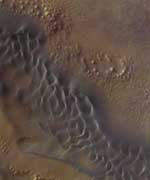
Image credit: NASA/JPL
The NASA/ASU THEMIS imaging team has released a photo of Mars which has been corrected as close as possible to realistic colour. This image of cliffs and basalt sand dunes in the southern Melas Chasma region of Mars was taken by NASA’s Mars Odyssey spacecraft. Astronomer and space artist Don Davis used photographs from the Hubble Space Telescope and his own experience to modify the colours in the picture until they looked natural.
This spectacular view of the sunlit cliffs and basaltic sand dunes in southern Melas Chasma shows Mars in a way rarely seen: in full, realistic color. The colorization is the result of a collaboration between THEMIS team members at Cornell University and space artist Don Davis, who is an expert on true-color renderings of planetary and astronomical objects. Davis began with calibrated and co-registered THEMIS VIS multi-band radiance files produced by the Cornell group. Using as a guide true-color imaging from the Hubble Space Telescope and his own personal experience at Mt. Wilson and other observatories, he performed a manual color balance to match more closely the colors of previous visual Mars observations. He also did some manual smoothing and other image processing to mimimize the effects of residual scattered light in the images. The result is a view of Mars that invites comparisons to Earth; a scene that one might observe out the window on a flight over the southwest United States, but not quite. The basaltic dunes are commonplace on Mars but a rare feature on Earth. The rounded knobs and elongated mesas on the canyon floor show an erosional style as exotic as Utah’s Bryce Canyon but wholly familiar on Mars. Although the inhospitable Martian atmosphere cannot be seen, the magnificent Martian landscape on display in this image beckons space-suited human explorers and the sightseers who will follow.
Initial image processing and calibration by THEMIS team members J. Bell, T. McConnochie, and D. Savransky at Cornell University; additional processing and final color balance by space artist Don Davis.
Original Source: NASA/ASU News Release
